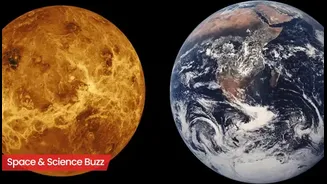Quantum Entanglement's Spooky Action
At the forefront of the bewildering world of quantum physics lies the phenomenon of quantum entanglement. This phenomenon illustrates how two particles
can become linked in such a way that they share the same fate, irrespective of the distance separating them. If one particle's state changes, the other instantaneously reflects that change, even if they are light-years apart. Albert Einstein famously called this 'spooky action at a distance' because it seemed to contradict the principles of special relativity, which dictates that nothing can travel faster than the speed of light. This instantaneous connection challenges our classical understanding of space and time, presenting a reality where particles are interconnected in a way that transcends conventional boundaries. This area of physics is now crucial in developing quantum computing and quantum communication technologies.
Dark Matter's Mysterious Presence
Dark matter is an unseen substance that accounts for around 85% of the total mass in the universe. We can't directly observe it with telescopes, as it doesn’t interact with light. Its existence is inferred from its gravitational effects on visible matter, like galaxies and stars. The rotation curves of galaxies, for instance, don’t match what is predicted based on the visible matter alone; they spin much faster than they should. This suggests that a significant amount of unseen matter is providing extra gravitational pull. Scientists are actively trying to detect dark matter particles through various experiments, using detectors placed deep underground to shield them from other forms of radiation. The nature of dark matter remains one of the biggest mysteries in cosmology, with many theories proposed about what it could be, including weakly interacting massive particles (WIMPs) and axions.
The Placebo Effect's Power
The placebo effect is a remarkable phenomenon where a person experiences a perceived benefit from a treatment that has no known therapeutic effects. This happens because the mind can influence the body, leading to changes like pain reduction, improved mood, or even physical healing. Studies have shown placebos to be effective in treating various conditions, including pain, depression, and even Parkinson's disease. The effectiveness of a placebo relies on factors such as the patient's expectations, the perceived authority of the healthcare provider, and the context in which the treatment is administered. This effect highlights the intricate link between our psychological and physiological states, emphasizing the importance of the mind-body connection in health and medicine. Understanding and harnessing the placebo effect could lead to the development of more effective treatments.
The Tardigrade's Resilience
Tardigrades, or water bears, are microscopic animals known for their incredible ability to survive extreme environments. These creatures can withstand conditions that would kill almost any other organism. They can endure extreme temperatures, both hot and cold, high levels of radiation, the vacuum of space, and lack of water for decades. When faced with adverse conditions, tardigrades enter a state of cryptobiosis, essentially shutting down their metabolic processes. In this state, they can survive dehydration, starvation, and oxygen deprivation. Once conditions improve, they rehydrate and resume their normal lives. The tardigrade's resilience is due to several adaptations, including specialized proteins that protect their cells and DNA from damage. Studying tardigrades provides valuable insights into how life can survive and adapt in extreme environments and could have implications for astrobiology and biotechnology.
The Power of Sleep
Sleep is a vital physiological process, and its impact on the body and mind is immense. During sleep, our brains perform crucial tasks like consolidating memories, clearing out toxins, and regulating emotions. Sleep deprivation can lead to a host of problems, including impaired cognitive function, increased risk of chronic diseases, and mood disorders. Even a small amount of sleep loss can significantly affect performance and well-being. Sleep is divided into various stages, each with specific functions. For example, deep sleep is essential for physical restoration, while REM sleep is associated with dreaming and memory consolidation. Maintaining a regular sleep schedule, creating a relaxing bedtime routine, and optimizing your sleep environment are essential for getting adequate and restorative sleep. Research in sleep science continues to unveil new discoveries about its importance for overall health and well-being.
The Complexity of Dreams
Dreams are complex cognitive experiences that happen during sleep, especially during REM (rapid eye movement) sleep. Dreams can be vivid, bizarre, and filled with emotions, often incorporating elements from our daily lives, memories, and subconscious thoughts. The exact function of dreams is still debated, but several theories suggest they play a role in memory consolidation, emotional processing, and problem-solving. Some researchers propose that dreams help us sort through and process information from the day, while others believe they reflect our deepest desires and fears. Dream content can vary greatly, influenced by individual experiences, cultural factors, and even external stimuli. Understanding dreams requires delving into the realms of neuroscience, psychology, and personal experiences. Analyzing dream patterns and content can provide insights into a person's mental and emotional state, which is why dream analysis remains a topic of interest.
The Immense Universe's Scale
The sheer scale of the universe is almost impossible to comprehend. The observable universe, the portion we can currently see, is estimated to be around 93 billion light-years in diameter. It contains billions of galaxies, each housing billions of stars, planets, and other celestial bodies. The distance between these objects is so vast that light, the fastest-moving entity in the universe, takes years, even billions of years, to travel from one place to another. This vastness also means that we are always looking into the past when we observe distant objects, as the light we see has taken a long time to reach us. Scientific advancements like powerful telescopes and space probes have provided us with a deeper understanding of the universe's size. Each new discovery further broadens our horizons and deepens our appreciation for its unfathomable size and complexity.
The Uniqueness of Fingerprints
The uniqueness of fingerprints is a cornerstone of forensic science. Each individual has a unique pattern of ridges and furrows on their fingertips, making them an ideal way to identify people. The formation of these patterns is determined by both genetic and environmental factors during fetal development. Even identical twins, who share the same DNA, have unique fingerprints. Fingerprints remain largely unchanged throughout a person's life, making them a reliable form of identification. The patterns are classified into different categories, such as arches, loops, and whorls, which are used to analyze and compare fingerprints. Advancements in technology, such as automated fingerprint identification systems (AFIS), have greatly improved the speed and accuracy of fingerprint analysis, making them crucial in criminal investigations and security measures.
The Human Microbiome
The human body is home to a vast community of microorganisms known as the microbiome. This community, consisting of bacteria, fungi, viruses, and other microbes, lives in and on our bodies, mostly in the gut. The microbiome plays a crucial role in human health, assisting with digestion, synthesizing vitamins, and modulating the immune system. The composition of the microbiome varies among individuals and is influenced by factors like diet, lifestyle, and genetics. An imbalance in the microbiome, known as dysbiosis, is linked to various health issues, including inflammatory bowel disease, obesity, and mental health disorders. Research into the microbiome is rapidly expanding, with scientists exploring ways to manipulate the microbiome through probiotics, prebiotics, and other interventions to improve health and treat diseases. Understanding the complex interactions within the microbiome is vital for advancing the fields of medicine and human health.
The Speed of Light's Limit
The speed of light, often denoted as 'c', is a fundamental constant in physics, with a speed of approximately 299,792,458 meters per second in a vacuum. According to Albert Einstein's theory of special relativity, nothing with mass can travel faster than the speed of light. As an object approaches the speed of light, its mass increases and it would require an infinite amount of energy to accelerate it further. This concept has profound implications for our understanding of space and time. It leads to phenomena like time dilation, where time passes slower for an object moving at high speeds relative to a stationary observer. This speed limit is a cornerstone of modern physics, shaping our understanding of the universe and its limitations. The implications of the speed of light have influenced everything from GPS technology to particle physics research.
The Diversity of Life
Earth is teeming with an astonishing diversity of life. From the microscopic bacteria to the massive blue whale, life on our planet displays an unparalleled range of forms, adaptations, and behaviors. Scientists estimate that there are millions of species, and many remain undiscovered. This biodiversity is the result of billions of years of evolution, driven by natural selection, genetic mutations, and environmental changes. Each species has unique characteristics that allow it to thrive in its specific environment, playing a crucial role in maintaining ecosystem balance. The study of biodiversity is critical for understanding the interconnectedness of life on Earth, how ecosystems function, and the impact of human activities on the planet. Protecting biodiversity is essential to the health of the planet and the well-being of all living things.
The Formation of Black Holes
Black holes are regions of spacetime where gravity is so strong that nothing, not even light, can escape. They form when massive stars collapse at the end of their lives, or through the collision of neutron stars. The event horizon is the boundary around a black hole beyond which escape is impossible, and the point of no return. Black holes come in different sizes, from stellar mass black holes, which are formed from the collapse of individual stars, to supermassive black holes, which reside at the centers of most galaxies. These supermassive black holes are millions or even billions of times more massive than the sun. The study of black holes provides valuable insights into the fundamental laws of gravity, astrophysics, and the nature of space and time. Scientists use advanced telescopes to study the effects of black holes, such as gravitational lensing and the emission of radiation as matter spirals into them.
The Scale of the Atom
Atoms, the fundamental building blocks of matter, are incredibly small, far beyond what the human eye can see. The diameter of a single atom is on the order of picometers. If you were to blow up an atom to the size of a football stadium, the nucleus, where most of the atom's mass is concentrated, would be the size of a tiny marble. Despite their size, atoms are mostly empty space, with electrons orbiting the nucleus. This empty space is due to the vast distances between the nucleus and the electrons. Understanding the structure and behavior of atoms is fundamental to many fields, from chemistry to materials science and quantum mechanics. Scientists use sophisticated tools, such as electron microscopes and particle accelerators, to study and manipulate atoms, revealing the inner workings of matter at its most fundamental level.
The Nature of Time
Time, a fundamental dimension, is often perceived as linear, flowing from past to present to future. However, our understanding of time is more complex than it seems. According to Einstein's theory of relativity, time is relative, meaning it can be affected by gravity and speed. Time dilation, which occurs in strong gravitational fields or at high speeds, can cause time to pass slower for observers. The concept of time travel, which has captivated imaginations for centuries, remains a theoretical possibility. While traveling to the future is theoretically possible, traveling to the past presents significant challenges. The nature of time is a subject of ongoing debate and research among physicists, philosophers, and scientists. There are several theories about the origin and the fundamental nature of time, but many questions are still unanswered.
The Fibonacci Sequence's Presence
The Fibonacci sequence is a mathematical sequence where each number is the sum of the two preceding ones, starting from 0 and 1. The sequence, 0, 1, 1, 2, 3, 5, 8, 13, and so on, appears surprisingly frequently in nature, from the arrangement of leaves on a stem to the spiral patterns of seashells and galaxies. The Fibonacci sequence is closely related to the golden ratio, approximately 1.618, which appears in various aspects of art, architecture, and design. The golden ratio and Fibonacci numbers provide a framework for creating visually pleasing and harmonious proportions. They are an example of the underlying mathematical patterns that govern natural and artistic structures. The Fibonacci sequence's appearance in nature is often cited as a demonstration of the order and beauty inherent in the universe and is also used in computer algorithms.
The Mysteries of Consciousness
Consciousness, the state of being aware of oneself and one's surroundings, is one of the greatest mysteries in science. Defining and understanding consciousness is a significant challenge, as it is subjective and difficult to quantify. There are many theories about how consciousness arises, but no single explanation is universally accepted. Some theories focus on the role of the brain, while others explore the relationship between consciousness and quantum mechanics. The hard problem of consciousness is the challenge of explaining how physical processes in the brain give rise to subjective experiences, known as qualia. Research into consciousness involves a wide range of fields, including neuroscience, psychology, philosophy, and computer science. Exploring the nature of consciousness is vital for understanding ourselves, our place in the universe, and the complexities of human experience.
The Sun's Energetic Output
The Sun, our nearest star, is an enormous source of energy, constantly radiating light and heat that sustains life on Earth. This energy is produced through nuclear fusion, a process in which hydrogen atoms fuse together to form helium, releasing vast amounts of energy in the process. The Sun's energy travels through space in the form of electromagnetic radiation, including visible light, ultraviolet rays, and infrared radiation. The sun's energy plays a crucial role in regulating Earth's climate, driving weather patterns, and supporting the processes of photosynthesis, which provides energy for plants. Scientists continuously study the Sun to understand its behavior and how it impacts Earth, as solar flares and coronal mass ejections can have adverse effects on technology and communications. Exploring the Sun's activity is crucial for space weather forecasting.
The Formation of Crystals
Crystals, fascinating natural structures, have a highly ordered, repeating arrangement of atoms or molecules. They form when a substance solidifies under specific conditions, allowing atoms to arrange themselves in a regular, repeating pattern. The resulting crystal structure determines its properties, such as its shape, hardness, and optical characteristics. The growth of crystals can occur through various processes, including evaporation, cooling, and precipitation from a solution. Different types of crystals, such as diamonds, quartz, and salt, form under varying environmental conditions. Scientists study crystals for their unique properties and uses, which range from electronics to jewelry and industrial applications. Understanding crystal formation provides insights into the physical and chemical properties of materials.
The Concept of Infinity
Infinity, often represented by the symbol ∞, is a concept representing something without any limit or end. It appears in mathematics, physics, and philosophy, and plays a fundamental role in our understanding of space, time, and quantities. Infinity is not a number, but a concept that is used to discuss concepts such as limits. Different types of infinity exist, such as the infinity of the natural numbers and the infinity of real numbers, which are of different sizes. Understanding infinity can be challenging, as it often goes against our intuitive understanding of the world. It is a concept that raises profound questions about the nature of reality, mathematics, and our ability to comprehend the vastness of the universe. Studying the concept of infinity helps to grasp the boundaries of our knowledge.
The Persistence of Memory
The human brain is an intricate organ that has the amazing capability to store and retrieve memories. Memories are not simply static recordings of past events but are reconstructed experiences, influenced by our emotions, beliefs, and current state. The brain has different types of memory, including short-term memory, long-term memory, and procedural memory. Memory is stored in a distributed fashion throughout the brain, involving various regions such as the hippocampus, amygdala, and cerebral cortex. The process of memory is prone to errors, which leads to inaccuracies or distortions in recall, highlighting the role that the context plays. Understanding the mechanisms of memory helps in the development of strategies to enhance memory and treat memory disorders, which are a very important part of modern medicine and psychology.













